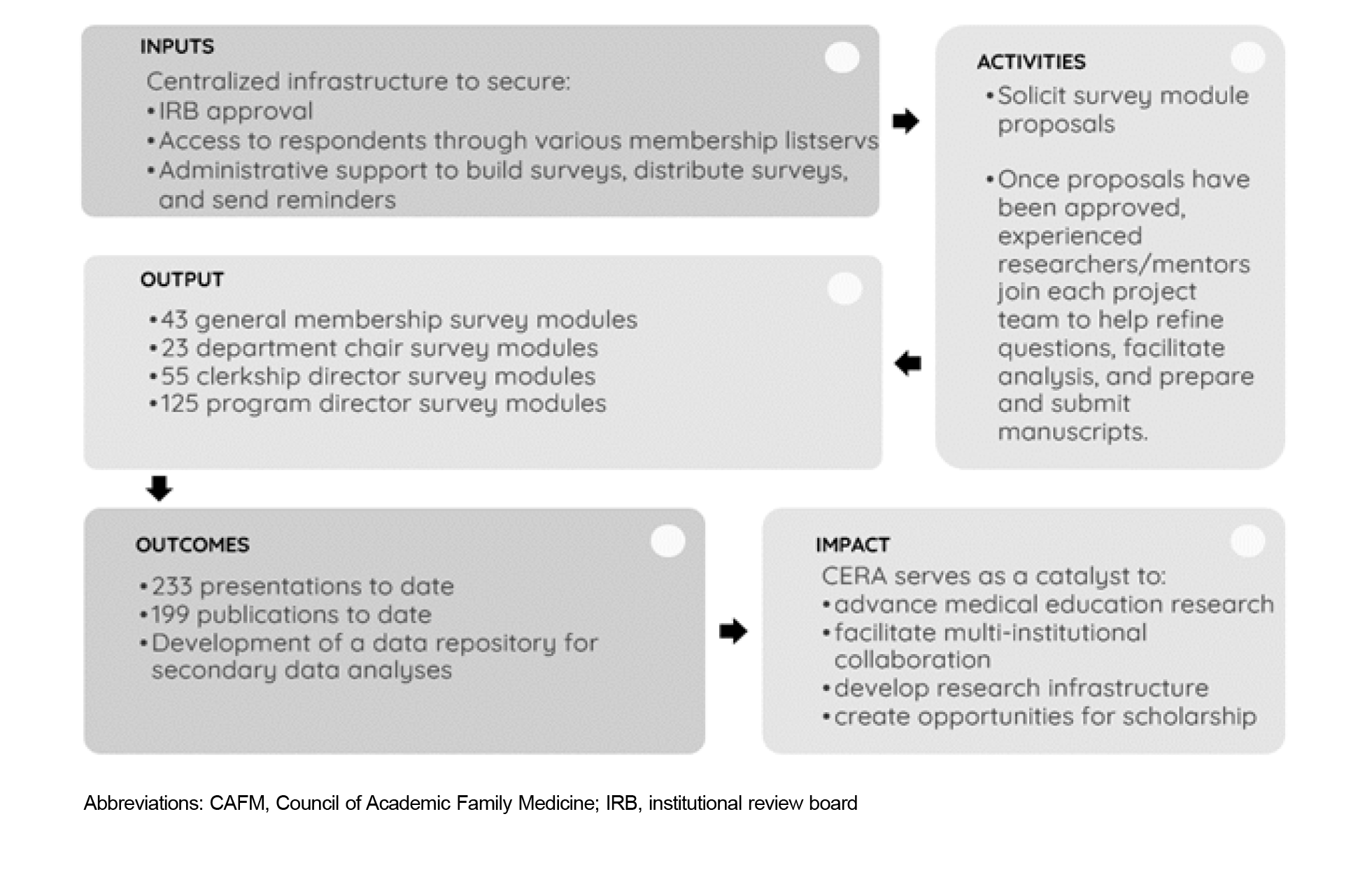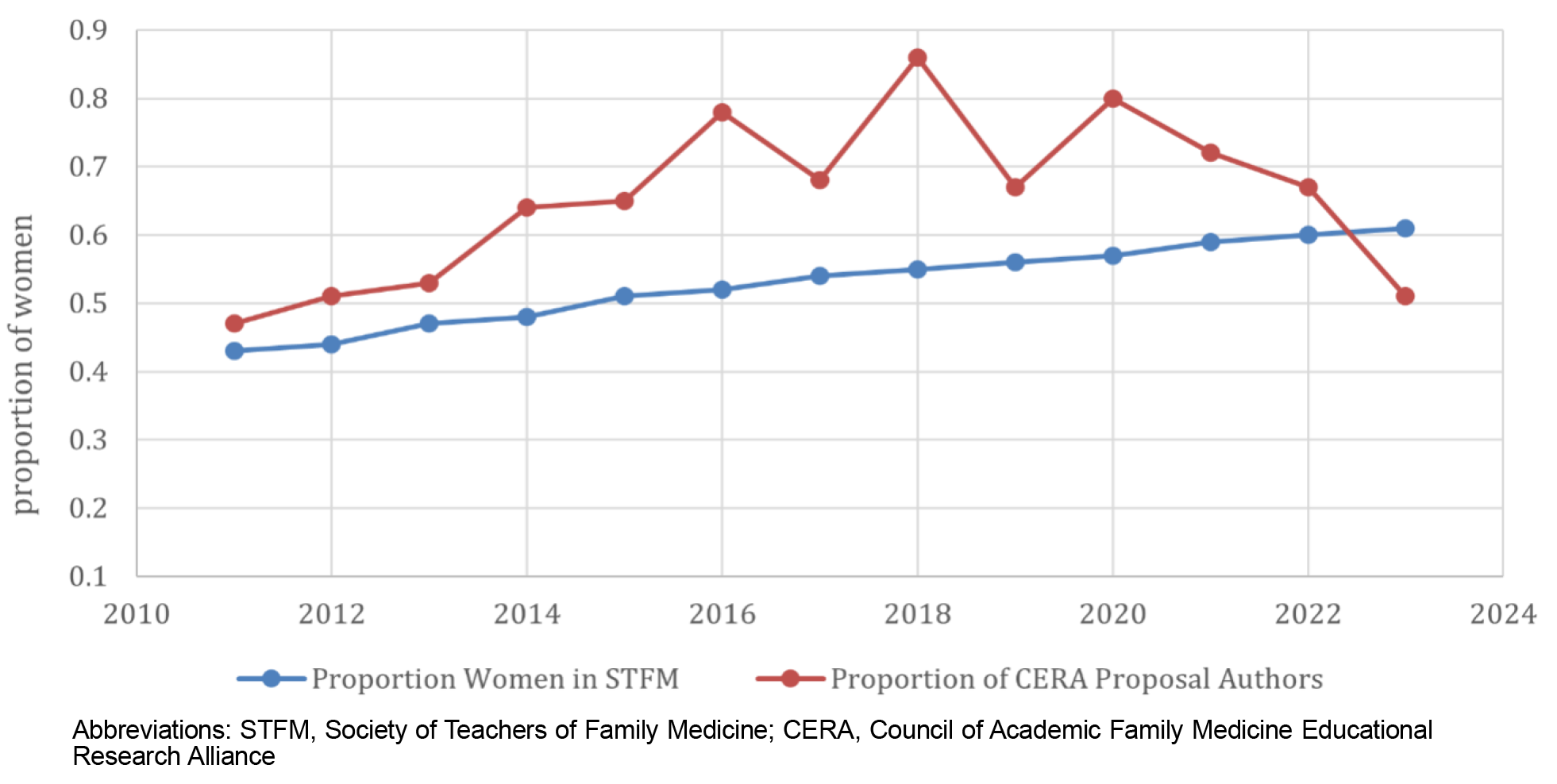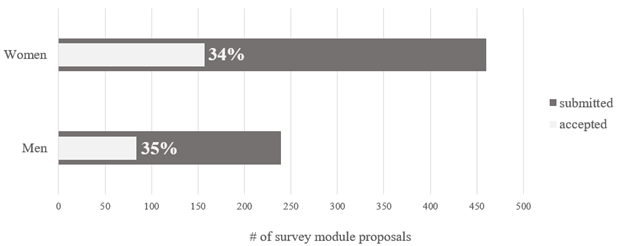Background and Objectives: The Council of Academic Family Medicine Educational Research Alliance (CERA) is a unique collaboration of academic family medicine organizations (Society of Teachers of Family Medicine [STFM], Association of Family Medicine Residency Directors, North American Primary Care Research Group, Association of Departments of Family Medicine) that facilitates and improves educational research in family medicine. CERA conducts approximately five surveys per year, including residency program directors, clerkship directors, department chairs, and general membership. Members of these organizations propose modules of 10 questions for these surveys. Proposals are peer-reviewed, and the top proposals are incorporated, along with standardized demographic questions, into an omnibus survey. We sought to determine the impact of self-reported gender of the primary submitter on survey module acceptance rates.
Methods: We conducted a bibliometric analysis to explore author characteristics and quantify dissemination efforts. We conducted ꭓ2 analyses to determine gender differences in proposal acceptance. We used the exact binomial test to compare proportions of women authors to the benchmark proportion of women in STFM.
Results: Overall, women submitted 66% (460/699) of CERA survey module proposals and authored 65% of accepted CERA modules (157/241) with the highest proportion concentrated among Clerkship Surveys (73%, 40/55). The acceptance rate did not differ significantly by gender (χ2=0.07, df=1, P=.80). A total of 73.4% (177/241) of module authors went on to present or publish their findings; we found no significant differences in scholarly output by gender (χ2=0.70, df=1, P=.41).
Conclusions: These findings indicate that the CERA module submission process has been successful in achieving comparable acceptance rates for men and women submitters. Other specialties should consider a similar model as a means to support early career educational researchers, including women.
Although some measures of gender disparities in academic medicine have improved over time, parity has yet to be achieved in leadership positions, including within family medicine. 1, 2 To close these gaps, a strong record of scholarly activity is needed to advance through the promotion and tenure process. However, gender disparities in academic publishing 3, 4 may hinder the goal of ensuring equitable representation at the leadership level. One avenue to explore current levels of gender disparity in scholarship is to assess medical education research facilitated by the Council of Academic Family Medicine Educational Research Alliance (CERA).
CERA is a unique organization that provides a way to systematize and improve educational research within a medical specialty, as described in Figure 1. CERA is a collaboration of the academic family medicine organizations (Society of Teachers of Family Medicine [STFM], Association of Family Medicine Residency Directors, North American Primary Care Research Group, and Association of Departments of Family Medicine) with the goal of facilitating and improving educational research in family medicine. 5-7 CERA conducts approximately five surveys per year of different subsets of family medicine educators: residency program directors (twice a year), clerkship directors, 8 department chairs, 9 and general membership 10 of academic family medicine organizations. Members of the CERA organizations can submit a proposed topic and question set, referred to as a module, for consideration in these surveys. Proposals are sent out for peer review, and the top proposals are incorporated into an omnibus survey, along with standardized demographic questions. Once a proposal is accepted, CERA provides a research mentor who assists with question refinement and preparation of a manuscript for publication. All final surveys are submitted to the American Academy of Family Physicians Institutional Review Board for ethics approval and distributed to CERA constituents via email, with reminder emails sent to nonrespondents. Once the survey response window has closed, the module submitters are provided with their data for analysis.
CERA has a unique mentorship framework that, to our knowledge, does not exist in other structured medical education surveys. Exploring the types of mentorship programs available to women in medicine, Farkas et al noted that many programs target junior faculty; however “the academic pipeline is leaky across the career trajectory, and while investment in trainees and junior faculty is important, midcareer faculty can also benefit from mentorship.” 11 The CERA framework is unique in that authors of all levels of experience have access to mentors. Authors engaging with CERA may request a mentor at any stage of the process, whether for assistance in developing research questions or crafting proposals. Furthermore, the authors of all accepted proposals are paired with a CERA mentor, selected based on author needs and mentor availability. Notably, all mentor requests to date have been accommodated. The availability and integration of mentors into the CERA process may serve to mitigate structural barriers traditionally hindering women authors’ scholarly success.
This study sought to determine whether a difference exists between module acceptance rates based on self-reported gender of the primary submitter. Our secondary assessment was to determine whether a gender difference existed in the frequency of publications and presentations following accepted modules. Although the CERA surveys provide an opportunity to gather national data on only family medicine education and clinical care, the overarching mechanism of allowing organizations within a topic area to survey their stakeholders on their professional practices and opinions and offer mentorship in survey scholarly activities is a powerful tool that could be replicated and tailored to other organizations. Overall, the CERA surveys are an efficient, effective avenue to publication for those interested in academic family medicine. We hypothesize that this streamlined process contributes to women faculty perceiving scholarly activity as more accessible, leading to a higher proportion of submissions from women.
Data Collection
Overall, 723 CERA survey module proposals submitted between June 2011 and July 2023 were eligible for inclusion in this study. Student, resident, and practice-based research network surveys were excluded because those were special surveys that are no longer conducted. The following data were collected: primary submitter name, degree, level of mentorship needed, submission due date, submission decision, and survey topic. Self-identified gender data were obtained via Council of Academic Family Medicine (CAFM) membership rosters.
The proportion of women in STFM was used as a benchmark to add context to CERA submission and acceptance rate data. To derive this benchmark, we calculated the proportion of women STFM members in 2023, including all membership types except for students and residents. This benchmark was selected because substantial overlap exists in membership among CAFM organizations, and most CERA submissions are from STFM members.
Resulting scholarly output was derived via correspondence from the authors and a search of the Web of Science and PubMed databases using the following terms: “CERA survey” OR “CERA Program Director Survey” OR “CERA Clerkship Director Survey” OR “CERA Department Chair Survey” OR “CERA general membership survey” OR “CAFM Educational Research Alliance” OR “Council of Academic Family Medicine Educational Research Alliance.” Data abstracted from Web of Science and PubMed included author names, manuscript title, journal name, volume number, publication date, and number of citations.
Statistical Analysis
We calculated descriptive statistics, including frequencies and percentages, for all quantitative variables. We conducted cross-tabulations and ꭓ2 analyses to determine whether the proportion of accepted proposals differed by gender. Because CERA does not limit the number of proposals an individual author can submit, we also used cross-tabulations to explore rates of resubmissions by gender. We used Cochran-Armitage tests to determine change over time. We used the exact binomial test to compare proportions of women authors to the benchmark proportion of those who self-identify as women in STFM. R statistical software version 4.2 (R Project for Statistical Computing) and SPSS statistical software version 28 for Windows (IBM) were used in the analyses. An α-threshold of P<.05 was used to determine statistical significance.
Of the 723 survey module proposals included in our study, gender data were available for 699 (97%) of primary submitters; individuals that chose not to disclose their gender (n=2) and those where gender data were unknown/missing (n=22) were excluded from analysis.
Submissions
Women submitted 66% (460/699) of survey module proposals overall. Compared to the benchmark proportion of women in STFM (60%), CERA survey module submissions drew a significantly higher proportion of women (66%, 95% confidence interval [62%, 69%], z=8.21, P<.01). Figure 2 details submission rates among various CERA survey audiences and shows that the Program Director Survey received the greatest proportion of submissions by women (67%). The Department Chair Survey resulted in the lowest total number of submissions (n=37) as well as the lowest proportion of women authors (57%). In our sample, 61% of authors submitted only one survey proposal during the study period, 20.7% submitted two proposals, and 14.2% submitted three or more, with similar patterns of resubmission among women and men (χ2=1.0, df=3, P=.80). The maximum number of proposals submitted by a single author across the 12-year study period was 16.
Though the proportion of women submitting proposals began to increase significantly from CERA’s inception in 2011 through 2016 (z=3.36, dim=6, P<.01, Cochran linear trend), this rate started steadily decreasing starting in 2020 (z=–3.77, dim=4, P<.01, Cochran linear trend), as depicted in Figure 3. For reference, the proportion of women among STFM membership showed a monotonic increase each year during the same time frame.
Accepted Proposals
The number of proposals submitted by each author ranged from 1 to 16 and did not differ significantly by gender. The proportion of women authoring accepted survey module proposals, stratified by survey audience, is presented in Figure 4. Women authored 65% (157/241) of accepted CERA survey modules overall, with the highest proportion among Clerkship Survey authors (73%, 40/55). The proposal acceptance rate did not differ significantly by gender (χ2=0.07, df=1, P=.79), as shown in Figure 5.
Dissemination
Although 73.4% (177/241) of survey authors went on to present or publish their findings, we found no significant differences in the amount of scholarly output (eg, publications, oral presentations, poster presentations) by gender (χ2=0.70, df=1, P=.41). Further analysis also showed no difference in type of scholarly output (publication or presentation) by gender (χ2=1.31, df=2, P=.52); conference presentations were the highest level of dissemination for 24.8% of women compared to 19% of men, whereas publications were the highest level of dissemination for 50.3% of women compared to 50.6% of men.
Since its inception, CERA has aimed to facilitate medical education research within family medicine. The CERA process involves several research stages, including pretesting, institutional review board approval, survey administration, and data collection, all managed independently by staff members of the CERA member organizations and volunteers on the CERA Steering Committee. While our study lacked the capacity to definitively assess the extent to which the mechanisms of CERA, such as mentors and staff/volunteer support, have contributed to the observed gender parity in CERA submissions, further qualitative assessments may offer valuable insights. Exploring best practices through qualitative evaluation could provide valuable lessons for other review committees aiming to address gender disparities in scholarly engagement.
Despite our overall positive outcome, we found a trend of increasing proportions of submissions by women with a peak in 2018, and then a subsequent decrease now reaching levels from 2012. One possible explanation is the recent downward trend results from COVID-19 pandemic impacts; specifically, women were disproportionally burdened with child or home care responsibilities during COVID-19. This trend is concerning and warrants continued observation and investigation. During this time, no change occurred in the module submission process or mentorship provided by CERA. One hypothesis is that an initial increase of submissions occurred early in the pandemic because those with administrative time were working from home and potentially had more time to submit. Similar trends in dissemination outcomes of family medicine scholars have been noted, 12 and CERA could have been impacted by this inflation. As workplaces have returned to prepandemic states and those in academic family medicine have adapted to new residency requirements and clinical care models, including new uses of telehealth, they may be spending less time focused on research.
Additionally, many of the accepted module submitters, both men and women submitters, have not yet disseminated their results. Although an inherent lag time exists between receiving data and dissemination, the factors leading to this gap in presentations and publications may be worth investigating. CERA could investigate the obstacles within the publication process encountered by their module submitters for opportunities to use the mentorship process to improve dissemination rates. The obstacles could be a specific area of focus of mentors because they tend to be more experienced researchers.
This study had several limitations. The demographics included self-reported information collected through membership profiles of organizational databases, and options are limited and not fully completed by all members. Demographic data were pulled from the current membership databases, and some information may have changed since the original submission date, particularly among earlier years. Additionally, gender reports in this case are binary and do not evaluate those who identify as nonbinary. Further, although we believe that CERA’s survey mechanism contributes to higher publication rates of the survey results, we were unable to compare the publication rate for the CERA survey mechanism to other survey mechanisms. We suspect that without a mechanism like CERA, its constituencies would be inundated with survey requests throughout the year, and response rates would be lower.
Although research has shown the importance of mentoring, especially for increasing publication by women in academic medical fields, 13, 14 we were unable to assess the impact of mentorship on CERA projects. Those submitting modules can request mentors at any stage, including prior to submission, or identify their own local mentor; therefore, each project receives different types and levels of mentorship. We found no indication in the data collected for this project regarding when the mentorship began and therefore whether it had any impact on module acceptance. Possibly modules resubmitted may have been more likely to have mentorship support.
Next Steps
Future opportunities include evaluation of mentorship and sponsorship differences among successful and unsuccessful submissions, because they are often cited as important for advancement. Because CERA has an embedded mentorship process, we plan to determine whether gender concordance of the mentorship pairs impacts presentation or publication success. Additionally, we plan to evaluate whether differences exist in senior author gender identity for the survey modules that successfully reach publication.
Overall, during the study period, we found a high proportion of submissions by women and no significant difference in acceptance rate based on the self-reported gender of the primary submitter. The proportion of women submitters did exceed the proportion of women members of the associated family medicine organizations. These findings support our hypothesis that the CERA survey submission process has been successful in achieving a comparable acceptance rate for men and women submitters. As previous work has indicated, smaller proportions of women authors have published in journals primarily focused on family medicine4; our results provide evidence that other specialties could increase the diversity of authorship and the quality of survey research in their topic areas using similar mechanisms for their stakeholders.
Acknowledgments
The authors thank Ray Biggs and the CERA Steering Committee for their expertise and assistance accessing the data.
References
-
Jacobs CK, Douglas M, Ravenna P, et al. Diversity, inclusion, and health equity in academic family medicine.
Fam Med. 2022;54(4):259-263.
doi:10.22454/FamMed.2022.419971
-
Adetoye M, Gold K. Race and gender disparities among leadership in academic family medicine.
J Am Board Fam Med. 2022;35(5):902-905.
doi:10.3122/jabfm.2022.05.220122
-
Malchuk AM, Coffman MS, Wilkinson E, Jabbarpour Y. Gender concordance of first and senior authors in family medicine journals.
Fam Med. 2021;53(2):92-97.
doi:10.22454/FamMed.2021.355251
-
-
Seehusen DA, Mainous AG III, Chessman AW. Creating a centralized infrastructure to facilitate medical education research.
Ann Fam Med. 2018;16(3):257-260.
doi:10.1370/afm.2228
-
Maxwell L, Mazzone M, Abercrombie S, et al. CERA: what? so what? now what?
Ann Fam Med. 2012;10(6):576-577.
doi:10.1370/afm.1455
-
Shokar N, Bergus G, Bazemore A, et al. Calling all scholars to the Council of Academic Family Medicine Educational Research Alliance (CERA).
Ann Fam Med. 2011;9(4):372-373.
doi:10.1370/afm.1283
-
-
-
Ho T, Marzolf BA, Curtin AD, Biggs R. Protocol for the 2023 CERA General Membership Survey. PRiMER. 2024;8:26. doi:10.22454/PRiMER.2024.609918
-
Farkas AH, Bonifacino E, Turner R, Tilstra SA, Corbelli JA. Mentorship of women in academic medicine: a systematic review.
J Gen Intern Med. 2019;34(7):1,322-1,329.
doi:10.1007/s11606-019-04955-2
-
Wright KM, Wheat S, Clements DS, Edberg D. COVID-19 and gender differences in family medicine scholarship.
Ann Fam Med. 2022;20(1):32-34.
doi:10.1370/afm.2756
-
Blumer V, Zhbannikov IY, Douglas PS. Contributions of women to cardiovascular science over two decades: authorship, leadership, and mentorship.
J Am Heart Assoc. 2023;12(5):e026828.
doi:10.1161/JAHA.122.026828
-
Diamond SJ, Thomas CR Jr, Desai S, et al. Gender differences in publication productivity, academic rank, and career duration among U.S. academic gastroenterology faculty.
Acad Med. 2016;91(8):1,158-1,163.
doi:10.1097/ACM.0000000000001219








There are no comments for this article.